Modiola caroliniana: A Bristly Drink
No one knows how many species of edible plants there are in the world, or in North America. In the former the guess is around 135,000, in the latter between four and six thousand, a margin of 50%. Of those perhaps 3,000 are reasonably well-known. There is still a lot to discover.
I would not be surprised to find close to two thousand edible species in Florida as it ranges over 400 miles from hilly temperate to nearly flat tropical. In fact I know of a survey that listed 1,700 edibles in the local area but that included subspecies and varieties including ferns and mushrooms. The point is one can always find an edible plant one had not known before, and that was my case about a decade ago with the Modiola caroliniana (moe-DYE-oh-lah care-row-lin-knee-ANN-ah (or AIN-ah.)
I don’t lead many foraging classes in large state parks because they usually are not where the common weeds or the people are. The edible plants are also few and far between, sometimes a half a mile or more whereas in an old city park one can often find a half-a-dozen edible within a square yard.
While scouting Lake Woodruff Wildlife Refuge for a suitable foraging class site an odd plant presented itself under the bird observation tower — read a plant that follows man’s feet rather than traveling solely by nature. Deep green, kind of looked like plump parsley, maybe a mallow of some kind. Low growing, alternating leaves, in a wet area but growing high and dry on a dirt road in partial sun.
Such discoveries can sometimes take months, if not years to identify. This time, however, I knew exactly where to look first: Weeds of Southern Turfgrasses by the University of Florida. I am very sure I use this book far differently than the authors intended. The book was put together to help home owners and businesses identify weeds in the lawn or golf courses so as to eradicate them. While they don’t say so, about half the plants in the book are edible, with good photos and descriptions. And there on page 152 was the object of my search, the Bristly Mallow, except it isn’t a mallow… well, that depends on how you use the word. It is in the greater Malvaceae family but its genus is not Malva. In fact, the Modiola caroliniana is the only species in its genus so there are no siblings to account for.
Whether the Modiola is edible is a bit of definition as well. Cornucopia II says on page 148: “Cajuns make a refreshing drink by soaking a handful of the leaves in a quart of water for two or more hours. Many drink it every day.”
That’s good news but elsewhere the information is not so encouraging. Dr. Daniel Austin in his huge tome, Florida Ethnobotany, says on page 442 it was used as a gargle for sore throats, tonsillitis and diphtheria; as an emollient and sedative, and to treat edema. One would presume it is a diuretic, and perhaps “refreshing” means relaxing. A cold water extract was used for a “healing bath” and it was also used for menstrual issues. It is suspected in the poisoning and paralysis of sheep, goats, and cattle. If it is troublesome to livestock in some degree or amounts it might be nitrate toxicosis, which is sometimes caused by Malva species.
It would seem on one end of the Modiola’s spectrum we have a … refreshing… drink and on the other a strong herb for medicinal uses. Approached correctly it’s probably a good plant to add to the bank of foraging knowledge.
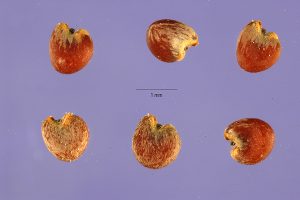
Carolina Bristle Mallow seeds. Not edible.
Where the plant came from originally is not certain. Most think South America then naturalized into tropical and warmer temperate parts of the world. In the US it is reported in Massachusetts, Pennsylvania then south to Florida and west to California, up to Oregon and in Hawaii. Nevada and the northern half of the US haven’t reported it (save for Pennsylvania and Massachusetts.) Elsewhere it is found from northern Argentina north, in northern Spain, northwest Portugal, northern Morocco, South Africa, southern peninsula India, Java, New Zealand (common in the Auckland area), the Chatham Islands, Australia (southern Queensland to southeast South Australia) Tasmania, southern Swanland, Norfolk Island, the Caribbean and Atlantic islands, including Bermuda, Hispaniola and Jamaica. (On a personal note it is all over my cousin’s farm in South Carolina.)
Modiola is from Greek and means the center of a wheel, a reference to the seed pod. Caroliniana means from Carolina, read the eastern North America (though we now know that not to be true.)
PS: If you are thinking of buying Weeds of Southern Turfgrasses purchase it through the University of Florida. The cost is around $22 including shipping. Some folks on the Internet are charging $100 for the same book. Read about it here.
Green Deane’s “Itemized” Plant Profile
IDENTIFICATION: M. caroliniana has prostrate, hairy stems, rooting at the nodes, which is also where flowering stems also grow. The leaves are variable, being up to 3 inches long to two inches wide, delta to kidney shaped, varying from shallowly toothed, to deeply toothed, 3- to 7-palmately lobed, and the lobes themselves often pinnately lobed. The small, long, hairy, persistent, stipules are leafy. Roots are tuberous.
TIME OF YEAR: Year round in warmer areas, summers in temperate areas
ENVIRONMENT: Orchards, vineyards, crop fields, gardens, urban sites, roadsides, dike roads and other disturbed, unmanaged sites.
METHOD OF PREPARATION: A drink: Soak a handful of leaves in a quart of water for two or more hours.

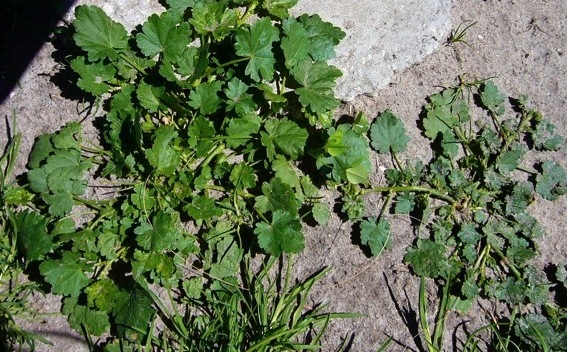
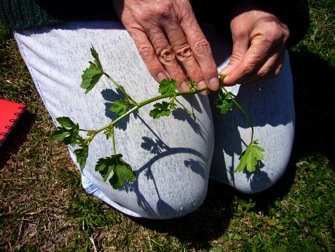
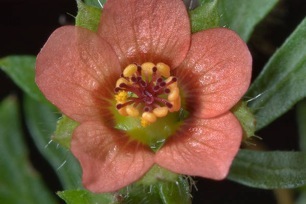
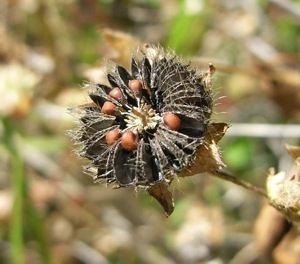

I can attest from personal experience that this plant is found in southern Texas and (at least in small quantities) I found the leaves to be tasty when eaten raw. The blossoms were bland and the seeds slightly sweet.
As a small child (I may have been 6 years old at the time), I and my numerous cousins would look for these low-growing, orange-flowered weeds on Grandma Brown’s farm. We would then pick the unripe seed heads, peel back the “petals” and eat the tiny green treats our small fingers dislodged. It’s 50 years later and I’m just now finding out what the name of this delightful little flower is. I doubt an adult forager would find much nutrition in these tiny bits of green, but nibbling on them was a delight for a bunch of bored kids.
Alright, there you are, you tiny orange beauty! I’ve been searching for your name for a while!
These Modiola caroliniana are also found in central Arkansas.
I live in South Africa and it is a common weed in gardens and lawns.
Found in Summerville,SC.
They grow in many parts of Texas. I’ve grown up with them in central and north Texas (Temple then Dallas), and Austin’s got plenty of it. It’s in bloom around my apartment complex right now, so I might try making tea or tasting a leaf. The idea of the unripened seeds tasting sweet is intriguing. Might also have to walk back outside and have a taste….
It’s growing among my salad leaves in Wimbledon, London,UK
It’s gone a long ways…
It’s growing on my hill in North Georgia, USA.
Found in Colbert, Ga. (I have a photo but cannot post it.)
Lake Jackson area in Leon County Florida. Found these not in bloom yet. We thought that it happened to be wild strawberries as we have them. What a Wonderful surprise to learn more.
Thank you very much for sharing this wonderful article/information.
Tallahasse, Lake Jackson area n.w. area is Very different in plant species than the Woodville, extremely southern end of Leon county.
Examples; Wild Blackberries are bigger and tastiest from the south side vs around n.w. side. We have a wild (bird dropping probably) Orange tree we re-planted and it’s growing huge tall now.
Wild Passion flowers/fruit here. Yummy and delicious wild grapes.
Our Guinea pig , loves the wild edibles. We do not use any pesticides. Leave the leaves alone so more fireflies/ lighting bugs and edibles grow.
I have MANY of these in by backyard. I’m looking forward to trying the beverage this week. It’s in the low hundreds here, a refreshing beverage would be good. I tried the little seed buttons in the spring while green. Just a little nibble here and there. Mildly sweet and reminiscent of okra pods.
I have another use other than what I’ve read here. I am trying to spend an hour or so a day barefoot in my backyard. ( see earthing movie)
The yard is mostly forest, sticks leaves and pecan debris. I’m working on making paths to the areas I’m working. I leave flat, soft plants on the paths, and. Water and tend them. Modilona works well for this purpose, as well as soft grasses, and horse herb, and feverfew.
Thanks for helping resolve my mystery. This plant has suddenly showed up in our neighborhood in New Zealand and seems to be trying to take over the world. At first it seemed very innocuous, but ah those creeping rhizomes. I’ve even dug them out from UNDER eight inches of old manure, and the adventurous rhizomes had GREEN leaves attached. My mind always asks… “What is this new plant? What is it trying to teach us? Does it have any practical uses for humans (food, health, dyeing, etc etc)… Interesting that Modiola caroliniana is reported mildly toxic to sheep and goats. Haven’t yet tried the cold infusion.
Just discovered in my backyard area. Southeast Georgia, near Savannah
Found a couple of months ago in lawn next to driveway to our community clubhouse. Took photos and did identify it, but had not seen this website til today. Never thought of search re edibility! Thanks.
Durham, North Carolina